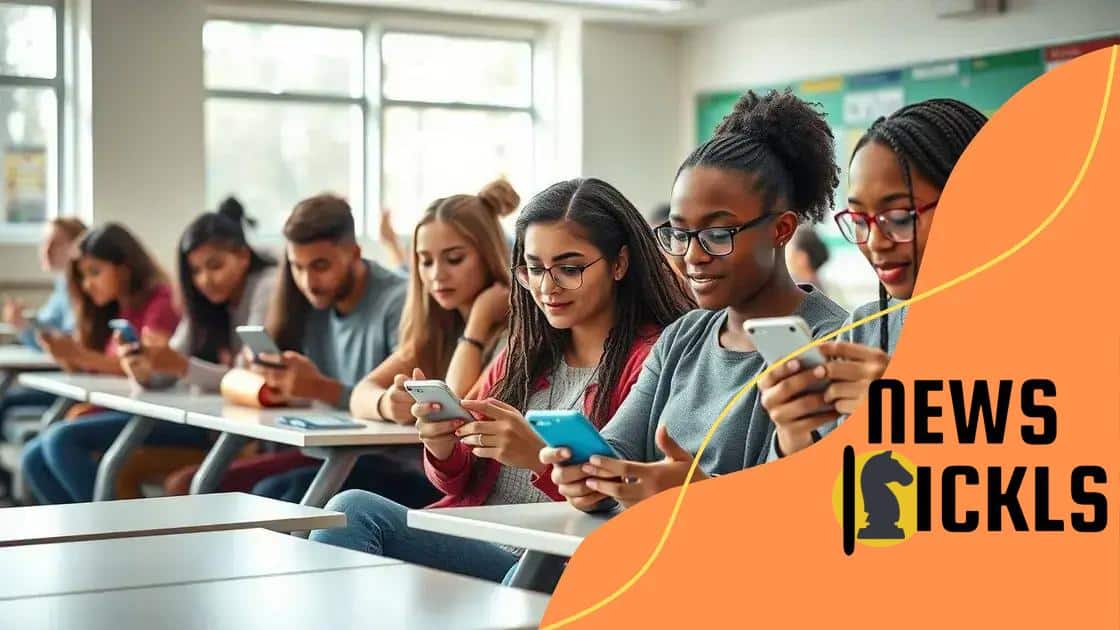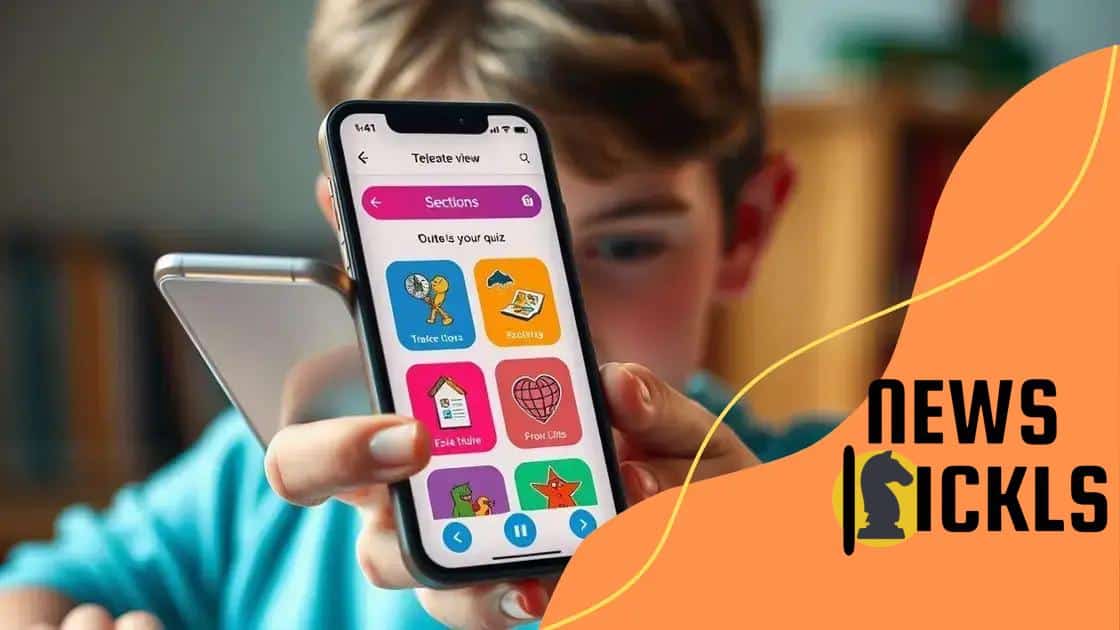The rise of mobile learning apps for high school students

The rise of mobile learning apps for high school students enhances educational accessibility and engagement, utilizing advanced technologies like AI and VR to provide personalized, interactive experiences.
The rise of mobile learning apps for high school students is changing how education is delivered. Imagine having a classroom in your pocket! With the increase in smartphone usage, students are now able to access learning materials anytime and anywhere. Let’s dive into how these apps are reshaping the educational landscape.
Understanding mobile learning apps
Understanding mobile learning apps is essential for modern education. These tools allow students to learn on the go, making education more accessible and flexible. With a smartphone in hand, learning is no longer confined to the classroom.
What are mobile learning apps?
Mobile learning apps are software applications designed specifically for educational purposes. They can be downloaded on smartphones or tablets, providing a wide range of educational resources. These apps can help with homework, practice skills, and even offer interactive learning experiences.
Key features of mobile learning apps
Many mobile learning apps have features that enhance the learning experience. Some of the important characteristics include:
- Interactive content: Games and quizzes keep students engaged.
- Accessibility: Students can access learning materials anytime, anywhere.
- Personalized learning: Many apps tailor content to suit individual learning speeds.
- Multimedia resources: Videos and animations can help explain complex topics.
These features help create a more engaging and effective learning environment. By using mobile apps, students can learn at their own pace, making the process less stressful.
Moreover, mobile learning apps can facilitate collaboration among students. Many apps incorporate social learning elements, allowing students to connect with peers. They can discuss assignments, share resources, and even collaborate on projects, fostering a sense of community.
Benefits of using mobile learning apps
The benefits of these apps are vast. They cater to various learning styles, ensuring that all students can find a method that works for them. The flexibility of learning via mobile devices can lead to better retention of information.
Additionally, these apps often provide instant feedback. This trait helps students identify areas where they might need improvement. With continuous practice and assessments, students can develop their skills effectively.
Benefits of mobile learning for students
The benefits of mobile learning for students are plentiful and impactful. As education evolves, mobile learning has emerged as a vital tool that enhances the learning experience in various ways.
Flexibility and Accessibility
One of the major advantages is flexibility. Students can learn whenever and wherever they wish. This accessibility allows them to study at their own pace, accommodating different learning styles. Busy schedules no longer hinder educational growth.
Engagement and Interactivity
Mobile learning apps often include engaging, interactive content. This can capture students’ attention and make learning enjoyable. By incorporating games, quizzes, and multimedia resources, these apps increase motivation. Students are more likely to participate actively when they find the material interesting.
- Gamification: Many mobile learning apps use gamification, turning lessons into fun competitions.
- Instant feedback: Quick assessments help students understand their strengths and weaknesses.
- Multimedia elements: Videos and animations simplify complex subjects.
- Peer interaction: Students can collaborate and share ideas easily through the apps.
This interactive environment fosters better retention of information. Students are likely to remember what they learn when they engage with the material actively.
Another significant benefit of mobile learning is personalization. Many apps adapt to each student’s needs, offering tailored content based on their skill level and progress. This ensures that every student receives a unique educational experience that fits their requirements. Through personalized learning paths, students can focus on areas where they need the most improvement.
Improved Efficiency
Mobile learning also promotes efficiency in studying. Students can manage their time better by using short learning modules. Instead of lengthy lectures, bite-sized lessons provide essential information quickly. This makes it easier for students to integrate learning into their daily routines.
Overall, mobile learning is revolutionizing the educational landscape. By offering flexibility, engagement, and personalized experiences, these apps are preparing students for success in a rapidly changing world.
Key features of effective learning apps

Understanding the key features of effective learning apps is crucial for students and educators alike. These features ensure that the apps not only provide information but also enhance the overall learning experience.
User-Friendly Interface
A significant characteristic of effective learning apps is their user-friendly interface. An intuitive design helps students navigate the app easily, making learning seamless. When students can find resources quickly, they spend more time engaging with the content.
Interactive Content
Interactive elements are essential for maintaining student interest. Engaging activities such as quizzes, flashcards, and games encourage users to participate actively. This level of interaction not only makes learning fun but also reinforces knowledge retention.
- Quizzes: Immediate testing of knowledge promotes active learning.
- Games: Incorporate educational content into fun activities.
- Discussion forums: Encourage collaboration among students.
- Multimedia content: Using videos and animations can simplify complex concepts.
Moreover, multimedia content supports different learning styles. Students who learn best through visual aids can benefit from videos, while those who prefer reading can utilize text-based information more effectively.
Personalization
Effective learning apps often include personalized learning pathways. These pathways adapt to the student’s pace, ensuring that they receive content suited to their current knowledge level. Personalization helps keep students motivated and engaged, as they can focus on specific areas needing improvement.
Regular Feedback
Instant feedback is another hallmark of a good learning app. When students receive immediate responses on their performance, they can identify strengths and weaknesses. This feedback loop allows them to adjust their study habits accordingly.
To sum up, effective learning apps are characterized by their user-friendly interfaces, interactive content, personalization, and the ability to provide regular feedback. These features combine to create a dynamic educational experience that keeps students engaged and enhances their learning outcomes.
Challenges faced by mobile learning initiatives
Mobile learning initiatives bring many advantages, but they also face several challenges that can hinder their effectiveness. Understanding these issues is key to improving educational outcomes.
Technical Issues
One major challenge is technical problems. Students may encounter issues such as slow internet connections or poorly designed apps that crash frequently. These technical glitches can frustrate learners and limit their ability to access learning materials efficiently.
Digital Divide
The digital divide is another significant obstacle. While many students have smartphones, not all have access to reliable internet. This inequity can create a gap in learning opportunities. Schools and communities must find ways to reduce this divide to ensure all students can benefit from mobile learning.
Learning Environment
In addition, the learning environment plays a crucial role. Students may find it challenging to focus on their studies when distractions are present at home or in public places. Without a conducive learning atmosphere, the effectiveness of mobile learning can be compromised.
- Distractions: Noisy environments can impact concentration.
- Self-discipline: Students may struggle to manage their time effectively.
- Lack of motivation: Online learning may not engage all students equally.
- Support systems: The absence of teachers or mentors can reduce accountability.
Many students also face challenges related to motivation and engagement. Without the physical presence of a teacher or classmates, some learners may struggle to stay focused. They might find it easy to procrastinate or lose interest in their studies.
Content Relevance
Furthermore, content relevance can be a concern. Not all mobile learning apps provide high-quality or relevant materials. Students may end up using resources that do not align with their curriculum, leading to gaps in knowledge.
To address these challenges, it is essential for educators, developers, and institutions to collaborate. By working together, they can create effective strategies that enhance mobile learning experiences. This collaboration can help improve the overall success of mobile learning initiatives and ensure that students have the best opportunities to learn.
Future trends in mobile education
Future trends in mobile education suggest exciting possibilities for learners everywhere. As technology continues to evolve, we can expect significant changes that enhance learning experiences.
Increased Use of Artificial Intelligence
One major trend is the incorporation of artificial intelligence (AI). AI can personalize learning by adapting content to suit individual needs. This means that as students progress, their apps can provide materials that match their learning pace and style.
Augmented and Virtual Reality
Another promising development is the use of augmented reality (AR) and virtual reality (VR) in education. These technologies can create immersive learning experiences, allowing students to explore complex subjects like science or history in an engaging way. Imagine studying biology by virtually exploring the human body!
- Enhanced engagement: AR and VR make learning more interactive and fun.
- Real-world applications: Students can practice skills in a safe environment.
- Collaboration: Virtual classrooms can connect learners around the globe.
- Diverse learning experiences: Different educational settings can aid understanding.
Moreover, mobile education will likely see an increase in collaborative learning tools. These tools can help students work together, even when they are apart. With features like shared documents and discussion forums, group projects become easier and more effective.
Focus on Skills Development
The future may also place a higher emphasis on developing practical skills. Apps could provide simulations and training that prepare students for real-world jobs. This approach equips students with valuable skills that employers seek.
In addition, we may witness a shift towards more inclusive learning environments. Apps and platforms are likely to become more accessible for students with disabilities, ensuring everyone gains the benefits of mobile education. Features like text-to-speech and customizable interfaces can make learning more inclusive.
Microlearning Strategies
Finally, microlearning will continue to gain popularity. This approach breaks down information into bite-sized lessons. Students can learn quickly and efficiently, fitting education into their busy schedules.
As we look ahead, the future of mobile education is bright. With advancements in technology and a focus on personalized, inclusive, and practical learning, students are poised for success in their educational journeys.
FAQ – Frequently Asked Questions about Mobile Learning Apps
What are the benefits of using mobile learning apps?
Mobile learning apps provide flexibility, engagement, and personalized learning experiences that fit different learning styles.
How can artificial intelligence enhance mobile education?
AI can personalize content, adapt lessons to individual student needs, and provide instant feedback to enhance the learning experience.
What challenges do mobile learning initiatives face?
Challenges include technical issues, the digital divide, distractions in learning environments, and ensuring content relevance.
What future trends can we expect in mobile education?
Future trends include increased use of AI, augmented reality, collaborative tools, microlearning strategies, and a focus on inclusivity.






